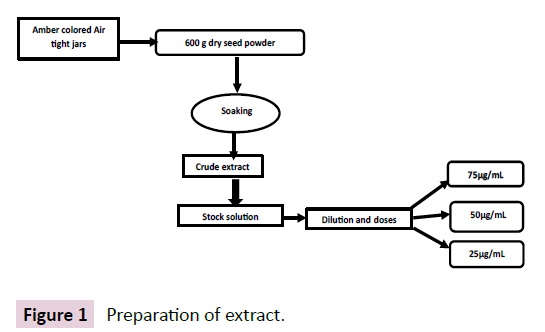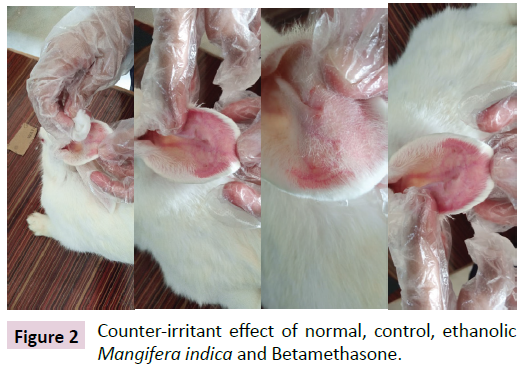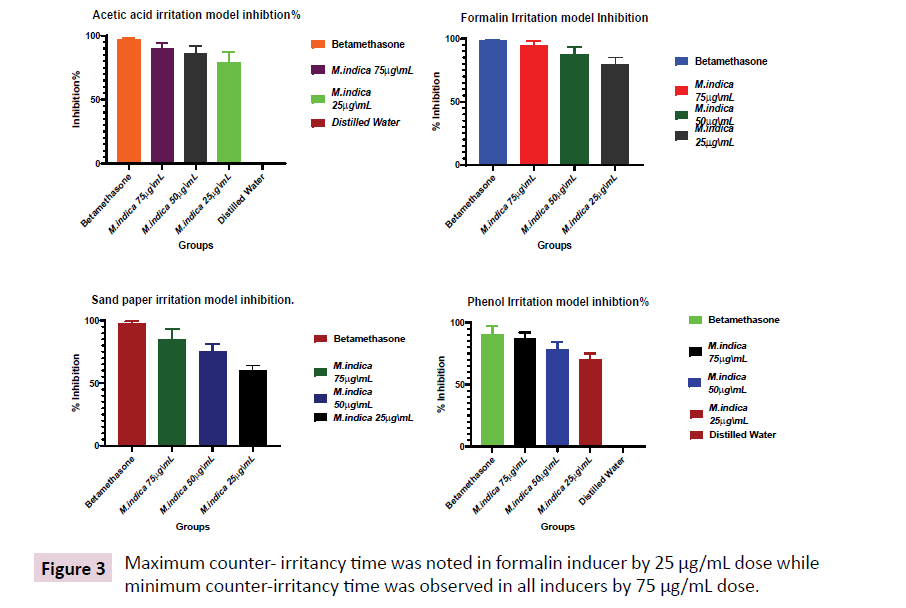ISSN : ISSN: 2576-1412
Journal of Applied Microbiology and Biochemistry
Dermatological Evaluation of Counter Irritant and Anti-inflammatory Effect of Ethanolic Extract of Seed of Mangifera indica in Rabbits
Ameen Abbas*1, Mashhud-ul-Hasan2, Amna Ramzan1, Eaman Ateeq1, Nazish Ramzan3,Usama Fiyyaz1, Areej Ateeq1, Komal Bukhari4 and Alisha Rehman4
1Department of Biochemistry, Muhammad Institute of Medical and Allied Sciences, Multan, Pakistan
2Department of Biochemistry, Baha Uddin Zakariya University, Multan, Pakistan
3Department of Chemistry, Baha Uddin Zakariya University, Multan, Pakistan
4Department of Physiotherapy, Muhammad Institute of medical and Allied Sciences, Multan, Multan-60000, Pakistan
- *Corresponding Author:
- Ameen Abbas
Department of Biochemistry
Muhammad Institute of Medical and Allied Sciences
Multan, Pakistan
E-mail: rammyali01@gmail.com
Received Date: November 25, 2021; Accepted Date: December 23, 2021; Published Date: December 30, 2021
Citation: Abbas A, Mashhud-ul-Hasan, Ramzan A, Ateeq E, Ramzan N (2021) Dermatological Evaluation of Counter Irritant and Anti-inflammatory Effect of Ethanolic Extract of Seed of Mangifera indica in Rabbits. J Appl Microbiol Biochem Vol.5 No.12:56
Abstract
The assessment of the effect of ethanolic Mangiferin in the treatment of irritation and inflammation on skin: the study was conducted at Muhammad Institute of Medical and Allied Sciences, Multan, in October 2021. Four groups of 12 rabbits; of either gender, were structured in this way that each group contained 3 rabbits. Anti-inflammatory activity was measured against betamethasone and potency of anti-inflammatory agents was examined by inducing inflammation through four different inducers phenol, formalin, acetic acid and sand paper. To treat ear distilled water was used as control group. Ethanolic extract of seed of Mangifera indica showed excellent counter irritant activity when compared with betamethasone and control group water. Maximum tolerated dose and minimum tolerated dose was calculated at an interval of 2 hours in (75, 50 and 25) μg/ml pattern. These doses with same pattern showed anti- inflammatory activity ranging between 93.01% to 75.13% in phenol 92.01% to 79.31% in acetic acid 94.02% to 79.21% in formalin and 93.12% to 60.21% in sand paper respectively. Ethanolic Mangiferin has the ability to lighten the effect of inflammation.
Keywords
Rabbits’ ear; Counter-irritant; Ethanolic Mangiferin; Betamethasone
Introduction
In case of tropic inflammation, increase of histamine level has been noted in the skin. Histamine is demonstrated as one of the major inflammatory mediators released by mast cells which are normally present in the connective tissue adjacent to blood vessels [1]. Histamine is also found in blood basophils and platelets. It is stored in mast cell granules and is released by degranulation in response to a variety of stimuli, including physical injury, such as trauma, cold or heat by unknown mechanisms or binding of antibodies to mast cells which underlie immediate hypersensitivity reactions [2]. Histamine causes dilation of arterioles and increases the permeability of venules. Histamine is considered the principal mediator of the immediate transient phase of increased vascular permeability, producing inter-endothelial gaps in post-capillary venules [3]. Its vasoactive effects are mediated mainly via binding to receptors, called H1 receptors, on microvascular endothelial cells. [4] The anti- histamine drugs that are commonly used to treat some inflammatory reactions, such as allergies, are H1 receptor antagonists that bind to and block the receptor H1 [5].
Mangiferin (1,3,6,7-tetrahydroxyxanthone C2-B-D-glucoside) is a polyphenolic compound extracted from various parts of Mangifera indica like roots, kernels, bark and flesh [6]. Mangiferin shows various pharmacological activities like anti-diabetic, antioxidant, anti-tumor, anti- inflammatory and anti-microbial [7]. Mango seed is rich in Mangiferin component and showed excellent anti-inflammatory activity when compared with mango peel [8]. Mangiferin has the ability to reduce Ig E and suppress anaphylactic reactions [9]. Expectedly, Mangiferin reduce the activity of release of histamine by different ways:
1) Suppress mast cells, basophils and plasma cells to release histamine.
2) Prevent the arachidonic acid to releases prostaglandin E which release higher concentration of histamine.
3) Block the activity of H1 receptor by its antagonists and keeping them inactive in cytoplasm [10].
Ethanolic Mangiferin is used to treat tropical inflammation as well as due to ethanolic extract it is also beneficial as anti-septic drug. The current study was designed to evaluate the effect of ethanolic extract of seed of Mangifera indica on experimentallyinduced irritation in rabbits.
Materials and Methods
The study was conducted at Muhammad Institute of Medical and Allied Sciences, Multan, in October 2021 and consisted of 12 rabbits of either gender. The rabbits were taken from Multan pet market, Punjab. The standard betamethasone was purchased from Ethical Laboratories (Pvt.) Ltd. Pakistan, while all chemicals were purchased from Solex Chemical (Pvt) Ltd-Multan.
The 12 rabbits (with a mean weight of 1.5 ± 03 kg) were kept under two-hour observation for initially assessment of dermatological and allergic behavior before analyzing the counter irritant activity. Animals were kept at Animal house of Muhammad Institute of Medical and Allied Sciences, Multan. They were kept in stainless steel cages and provided with good diet that´s commercially available. The experiments were carried out according to the rules of Institute of Laboratory Animal Resources, Commission of life sciences, Natural research council and approved by The Animal Ethical Committee of Muhammad Institute of Medical and Allied Sciences, Multan, Pakistan.
The fresh seeds of the plant Mangifera indica were collected from Khand Mangoes Farm, Multan. Seeds were authenticated by the cooperation of expert taxonomist at the Department of Botany, Baha Uddin Zakariya University, Multan and seed specimen were subjected for record.
For the preparation of extract, first of all the fresh seeds of mango were subjected for shade drying. All the adulterants and vegetative wastes were removed from vegetative material by manual picking before grinding into coarse powder with the help of special herbal grinder. The solution of coarse powder was prepared with ethanol and stored in the air tight jars. The filtrate was evaporated at room temperature under reduced pressure on rotary evaporator. The obtained extract was stored at -20°C in amber colour airtight jars in laboratory refrigerators (Figure 1).
The anti-inflammatory activity was determined by crude extracts against betamethasone (standard). The potency of antiinflammatory agents was measured by inducing the inflammation in the experimental animal. Maximum tolerated dose and minimum tolerated dose was calculated at an interval of 2 hours in (75, 50 and 25) μg/ mL pattern (Figure 2).
All rabbits were divided into four (G1, G2, G3 and G4) groups. Each group contained 3 rabbits. Irritation was induced in G1 by anti-clock wise application of sand paper on both ears. Induction of redness and erythema were observed and recorded. Standard betamethasone was applied on one ear while the other ear was treated with ethanolic Mangiferin extract of 75 μg/mL dose in first rabbit, 50 μg/mL in second rabbit and 25 μg/mL in third rabbit. The time, dosage and degree of counter-irritancy were noted (Table 1). Same method with remaining three inducers (phenol, formalin, acetic acid) was re-examined in G2, G3 and G4 groups (Figure 3). Decrease in redness and erythema was observed and recorded (Table 2).
| Extract Conc. mg/ml |
Phenol Irritation Inhibition (%) | Acetic acid Irritation Inhibition (%) |
Formalin Irritation Inhibition (%) |
Sand paper Irritation Inhibition (%) |
|---|---|---|---|---|
| Mangifera indica 25 µg/mL | 75.13 | 79.31 | 79.21 | 60.21 |
| 75.10 | 78.90 | 79.14 | 60.12 | |
| 74.21 | 78.01 | 78.99 | 59.99 | |
| Mangifera indica 50 µg/mL | 89.11 | 85.91 | 87.11 | 78.13 |
| 89.09 | 85.19 | 87.03 | 78.31 | |
| 89.02 | 85.02 | 87.00 | 78.01 | |
| Mangifera indica 75 µg/Ml | 93.21 | 92.12 | 94.29 | 93.29 |
| 93.12 | 92.20 | 94.92 | 93.92 | |
| 93.01 | 92.01 | 94.02 | 93.12 | |
| Betamethasone | 98.31 | 97.21 | 98.21 | 97.38 |
| 98.13 | 97.12 | 98.12 | 97.31 | |
| 98.23 | 97.09 | 98.09 | 97.09 |
Table 1 Counter-irritant activity.
| Groups | Phenol (min) | Acetic Acid (min) | Formalin (min) | Sand Paper (min) |
|---|---|---|---|---|
| Mangifera indica 25 µg/mL | 13 | 12 | 14 | 13 |
| Mangifera indica 50 µg/mL | 10 | 9 | 11 | 10 |
| Mangifera indica 75 µg/mL | 3 | 3 | 3 | 3 |
| Betamethasone | 2 | 2 | 1 | 1 |
Table 2 Counter irritant activity of groups in minutes.
Results
All three doses showed moderate to excellent counter-irritant effect in dose-dependent manner on the rabbit´s ear. The dose of 75 μg/mL showed maximum anti-inflammatory activity in sandpaper irritation model by 93.12%. The maximum inflammatory healing response was examined by 75 μg/mL dose.
Discussion
Different pharmacological aspects are responsible for antiinflammatory activity [11]. Mangiferin from mango seed has been identified which is demonstrated as to be involved in several activities. For instance, it prevents tumor formation, extends life span and is possible cure for diabetes, asthma and all inflammatory responses [12]. It has advantage over the betamethasone as its multiple uses do not cause any harm rather than stinging and dryness as does betamethasone [13]. Xanthoid structure of Mangiferin; rich source of polyhydroxy components, contributes to its free radical scavenging ability leading to multiple biological activities [14]. The presence of Mangiferin was bound to react with the irritated and inflamed cell membrane. Subsequently, the irritated and damaged superficial and deeper layers healed [15]. Furthermore, anti-septic activity of ethanol is effective at killing microbes, bacteria and other microorganisms on the surface of damaged skin [16]. Moreover, there is no evidence of adverse side effects of Mangiferin [17]. Hitherto, Mangiferin could be a promising candidate to development of multiple drugs.
Conclusion
Ethanolic extract of kernel of Mangifera indica countered the effect of irritation in experimental animal also showed a significant effect in terms of dose when compared with controls and standard betamethasone.
References
- Akerman S, Williamson DJ, Kaube H, Goadsby PJ (2002 Nov 22) The role of histamine in dural vessel dilation. Brain Res 956: 96–102.
- Asako H, Kurose I, Wolf R, DeFrees S, Zheng ZL, et al. (1994) Role of H1 receptors and P-selectin in histamine-induced leukocyte rolling and adhesion in postcapillary venules. J Clin Invest 93: 1508- 1515.
- Willis AP, Leffler CW (1999) NO and proteinoids: Age dependence of hypercapnia and histamine-induced dilations of pig pial arterioles. Am J Physiol - Heart Circ Physiol 277: 299-307.
- Togias A (2003) H1-receptors: Localization and role in airway physiology and in immune functions. J Allergy Clin Immunol 112: 60-68.
- Cowden JM, Zhang M, Paul J, Thurmond RL (April 2010) The histamine H4 receptor mediates inflammation and pruritus in Th2-dependent dermal inflammation. J Invest Dermatol 130: 1023-1033.
- Jyotshna, Khare â?ªP, Shanker K (2016) Mangiferin: A review of sources and interventions for biological activities. Biofactors 42: 504-514.
- Stohs SJ, Swaroop A, Moriyama H, Bagchi M, Ahmad T, Bagchi D (2018) A review on antioxidant, anti-Inflammatory and gastroprotective abilities of mango (Mangifera indica) leaf extract and mangifein. J Nutr Health Sci 5: 302.
- Kuganesan â?ªA, Thiripuranathar â?ªG, Navaratne A, Paranagama P (2017) Antioxidant and anti-inflammatory activities of peels, pulps and seed kernels of three common mango varieties in Sri Lanka. Int J Pharm Sci Res 8: 70-78.
- Rivera DG, Hernandez I, Merino N, Luque Y, Alvarez A, Martin Y, Amador A, Nuevas L, Delgado R (2011) Mangifera indica L. extract (Vimang) and Mangiferin reduce the airway inflammation and Th2 cytokines in murine model of allergic asthma. J Pharm Pharmacol 63: 1336-1345.
- Claudia A, Fabio S, Sato MN, Pietrobon AJ (Oct 26 2021) Role of histamine in modulating the immune response and Inflammation. Mediators Inflamm.
- Gerald A, Roderick J, John R, Gyengesi E, Bennett L (2021 Oct 27) A new approach to anti-inflammatory drugs. Food Funct 28: 1959-1961.
- Saha S, Sadhukhan P, Sil PC (2016) Mangiferin: A xanthonoid with multipotent antiâ?inflammatory potential. Biofactors 42: 459-474.
- Kumaran MS, Kaur I, Kumar B (2006) Effect of topical calcipotriol, betamethasone dipropionate and their combination in the treatment of localized vitiligo. J Eur Acad Dermatol Venereol 20: 269-273.
- Rivera DG, Balmaseda IH, Leon AA, Hernandez BC, Montiel LM, et al. (2010) Antiâ?allergic properties of Mangifera indica L. extract (Vimang) and contribution of its glycosylation Mangiferin. J Pharm Pharmacol 58: 385-392.
- Mei S, Ma H, Chen X (2021) Anticancer and anti-inflammatory properties of Mangiferin: A review of its molecular mechanisms. Food Chem Toxicol 149:111997.
- Blech MF, Hartemann P, Paquin JL (2021 Oct 27) Activity of non-antiseptic soaps and ethanol for hand disinfection. Zentralbl Bakteriol Mikrobiol Hyg B 181: 496-512.
- Telang M, Dhulap S, Mandhare A, Hirwani R (2013) Therapeutic and cosmetic applications of Mangiferin: A patent review: Expert opinion on therapeutic patents. Expert Opin Ther Pat 23: 1561-1580.
Open Access Journals
- Aquaculture & Veterinary Science
- Chemistry & Chemical Sciences
- Clinical Sciences
- Engineering
- General Science
- Genetics & Molecular Biology
- Health Care & Nursing
- Immunology & Microbiology
- Materials Science
- Mathematics & Physics
- Medical Sciences
- Neurology & Psychiatry
- Oncology & Cancer Science
- Pharmaceutical Sciences



